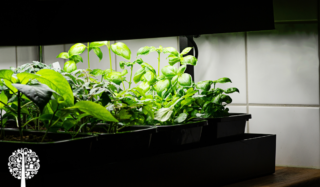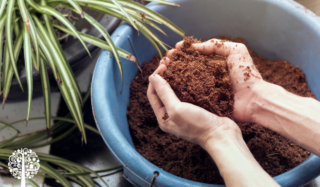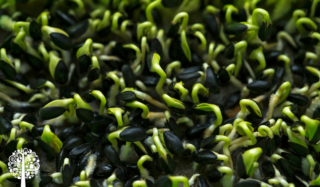A strange sense of desire and urgency came over me one day when I was on Galiano a few years ago, and suddenly, I knew I needed to start growing food indoors. I needed to start fixing what was seemingly becoming an issue for many Canadians: access to fresh food. I immediately contacted friends in the growing industry to decide how to move forward with my indoor farm. This seemingly random desire to grow food has become more than just a hobby; it’s a near obsession.
Part of my obsession with having year-round access to all types of food is creating the right, cost-effective environment. I have been experimenting with this for three years and have spent a lot of time trying to perfect indoor food production. There is no reason for everyone not to produce food on a small scale at home. Over the years, society has removed people from nature; it’s time we reintegrate into the art of growing food for ourselves.

Choose Your Weapon
Small-scale indoor farming is relatively easy and cheap and doesn’t involve much work. However, as with most designs, the only thing the same is they are all different. We can grow indoors in many ways; one method is not better. Whether using hydroponics or soil, choose the right approach for you. On my farm, we use soil-based media. But if I lived in an apartment, I would seriously consider a media-less environment. Below, I will describe a simple and successful way to grow microgreens indoors using soil.
Microgreens
At Galiano Grow House, our primary focus for indoor food production started with microgreens. These small and fast-growing greens pack a substantial nutritional load and grow quickly. They are typically ready to eat in 8-14 days and require few nutrients and little artificial light. For microgreens, our typical crops include speckled peas, sunflowers, radishes, lentils, popcorn, fava bean, and buckwheat. My favorite, and one of the easiest to grow, is sunflower sprouts.
Materials For A Single Rack:
- LED clone lights (2 @ 20 Watts per level) We use AELIUS LED
- 18″ -24″ by 48″ rack for growing, ideally with five shelves
- 20-30 Quad thick (ideally very thick as they last longer) trays
- Seed (preferably local and organic)
- Hypochlorous acid generator
- Misc. hand tools, knives, etc.
General Tips
WATER TEMPERATURE
- Water the prepared trays with warm (not hot) water (this is more important in the winter season).
- Always water the plants with room temperature water.
- Rince harvested microgreens with the coldest water possible before drying.
HYPOCHLOROUS
- The hypochlorous must be made every day and used fresh.
- Make the hypochlorous with room temperature water.
- Trays that only served as a lid can be sprayed with hypochlorous and used again without washing.
Prepare by mixing:
- 1L of water
- One teaspoon of sea salt
- One teaspoon of white vinegar
Plug in the Hypochlorous Acid Generator and activate the first cycle. The Hypochlorous needs two cycles before it is ready.
SOIL MEDIA PREPARATION
- Peat
- Coco Earth
- Perlite
- 50-gallon container (or any big container)
- 2L pot
- Shovel
- Gloves (optional)

MIXING INSTRUCTIONS
- The microgreen soil media mix is composed of peat, coco coir and perlite in a ratio of 3-1-1.
- With the 2L pot, scoop in the three components in this order: Peat-coco-peat-perlite-peat, and keep repeating until reaching the required quantity; always finish with the peat.
- Mix thoroughly with a shovel.
Store the peat and soil media mix in barrels outside the grow room and cover them with a lid. During the winter, the materials can freeze and harden. Break the frozen clumps with a shovel before using the mix. During more humid seasons, the peat can grow mouldy when stored in the bag. When putting the peat in the barrel, mix well so it can oxygenate and dry.
TRAY PREPARATION
You will need:
- 10′ x 20′ microgreen tray
- Soil media mix
- 2L pot
Using the 2L pot, scoop the soil media mix two times per tray for 4L of soil media per tray. Spread the soil evenly, breaking any clumps as you go.
Growing Sunflower Sprouts
Add 100g of sunflower seeds to a 750 ml container and fill halfway with a mix of water and silica. Soak for 16-22 hours; if using large sunflower seeds, six hours will suffice.

After soaking, rinse the seeds and water the prepared tray of soil media before planting. Gently sprinkle the seeds evenly throughout the soil mix, then cover them with a clean tray weighted with rocks, wood, or slates so the seeds press into the media.
The day after planting, and every day after that, mist the seeds with water and spray them with hypochlorous acid. Nine to 12 days after planting the seeds, remove the lid and place the sprouts under the grow lights. Gently remove the shells from the greens.
Harvest Time
By day 13, the sprouts will be ready to harvest! Do not water microgreens before picking them; water generously the day before. Safely use a knife for harvesting. After, wash and dry them in a salad spinner. After washing, the sprouts will last longer if completely dry, so placing them on a tray under a fan is a good idea. Then, collect the greens and store them in a container in the fridge.
Before planting another crop, washing all of your trays well in a sink is essential. Spray them with hypochlorous acid and allow them to dry.
Growing microgreens at home is easy and fun! Enjoy your nutritious harvest in salads, omelets, sandwiches, and more!